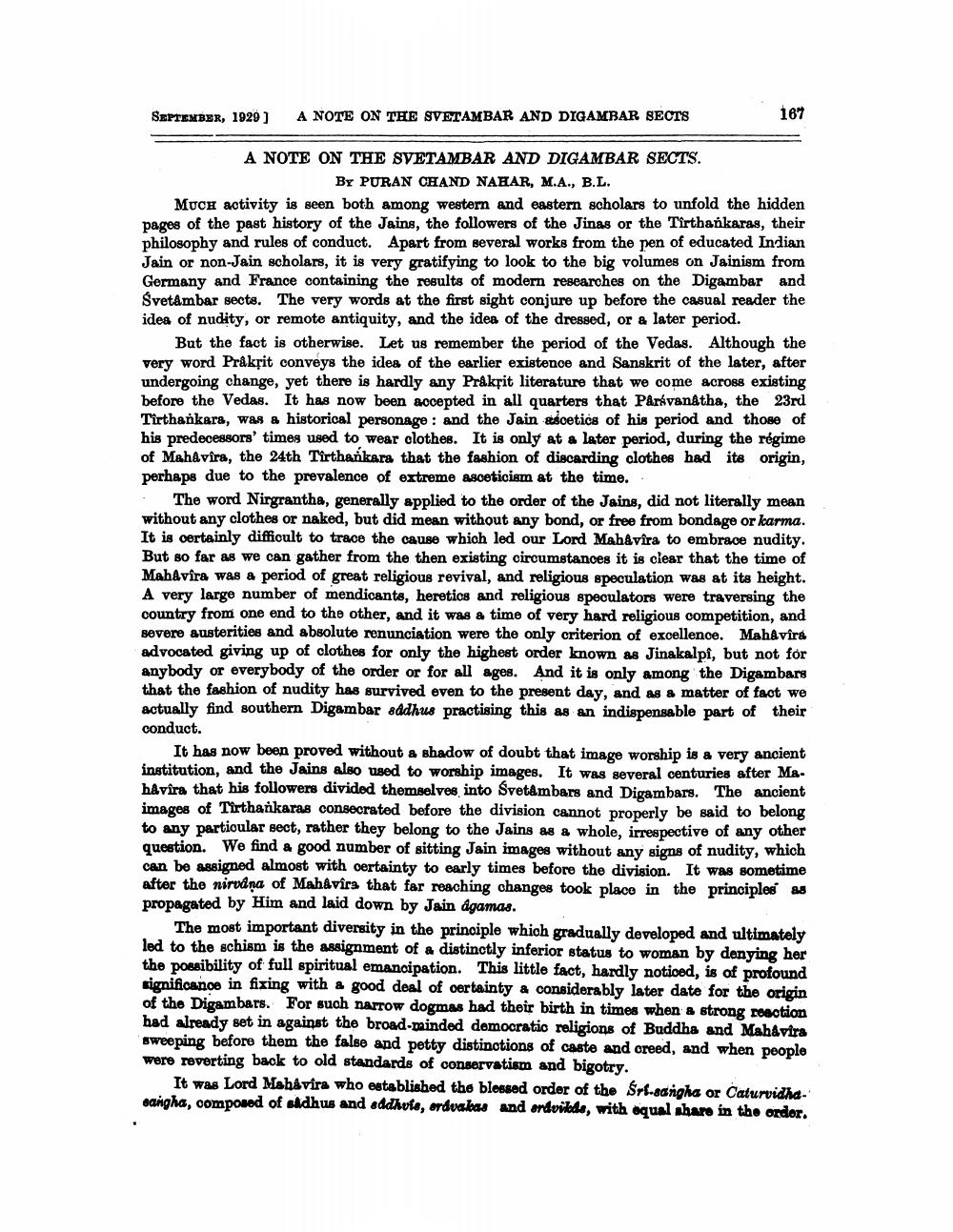________________
SEPTEMBER, 1929 )
A NOTE ON THE SVETAMBAR AND DIGAMBAR SECTS
167
A NOTE ON THE SVETAMBAR AND DIGAMBAR SECTS.
BY PURAN CHAND NAHAR, M.A., B.L. MUCH activity is seen both among western and eastern scholars to unfold the hidden pages of the past history of the Jains, the followers of the Jinas or the Tirthankaras, their philosophy and rules of conduct. Apart from several works from the pen of educated Indian Jain or non-Jain scholars, it is very gratifying to look to the big volumes on Jainism from Germany and France containing the results of modern researches on the Digambar and Svetambar sects. The very words at the first sight conjure up before the casual reader the idea of nudity, or remote antiquity, and the idea of the dressed, or a later period.
But the fact is otherwise. Let us remember the period of the Vedas. Although the very word Prakrit conveys the idea of the earlier existence and Sanskrit of the later, after undergoing change, yet there is hardly any Praksit literature that we come across existing before the Vedas. It has now been accepted in all quarters that Pårávanátha, the 23rd Tirthankara, was a historical personage : and the Jain ascetics of his period and those of his predecessors' times used to wear clothes. It is only at a later period, during the regime of Mahavira, the 24th Tirthankara that the fashion of discarding clothes had its origin, perhaps due to the prevalence of extreme asceticism at the time. . The word Nirgrantha, generally applied to the order of the Jains, did not literally mean without any clothes or naked, but did mean without any bond, or free from bondage or karma. It is certainly difficult to trace the cause which led our Lord Mahavira to embrace nudity. But so far as we can gather from the then existing circumstances it is clear that the time of Mah&vira was a period of great religious revival, and religious speculation was at its height. A very large number of mendicants, heretics and religious speculators were traversing the country from one end to the other, and it was a time of very hard religious competition, and severe austerities and absolute renunciation were the only criterion of excellence. Mahavira advocated giving up of clothes for only the highest order known as Jinakalpi, but not for anybody or everybody of the order or for all ages. And it is only among the Digambars that the fashion of nudity has survived even to the present day, and as a matter of fact we actually find southern Digambar addhus practising this as an indispensable part of their conduct.
It has now been proved without a shadow of doubt that image worship is a very ancient institution, and the Jains also used to worship images. It was several centuries after Ma. håvira that his followers divided themselves into Svetambars and Digambars. The ancient images of Tirtharkaras consecrated before the division cannot properly be said to belong to any partioular sect, rather they belong to the Jains as a whole, irrespective of any other question. We find a good number of sitting Jain images without any signs of nudity, which can be assigned almost with certainty to early times before the division. It was sometime after the nirudna of Mahavirs, that far reaching changes took place in the principles as propagated by Him and laid down by Jain dgamas.
The most important diversity in the principle which gradually developed and ultimately led to the schism is the assignment of a distinctly inferior status to woman by denying her the possibility of full spiritual emancipation. This little fact, hardly noticed, is of profound significance in fixing with a good deal of certainty a considerably later date for the origin of the Digambars. For such narrow dogmas had their birth in times when & strong reaction had already set in against the broad-minded democratic religions of Buddha and Mahavira sweeping before them the false and petty distinctions of caste and creed, and when people were reverting back to old standards of conservatism and bigotry.
It was Lord Mahavira who established the blessed order of the Sri-sangha or Caturvidhasangha, composed of sadhus and addhuis, ordvalas and andvilds, with equal share in the order.




